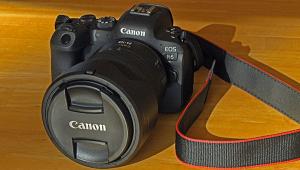Canon EOS M10 Mirrorless Camera Review


(Editor's Note: Lab Review lab tests and comments are supplied by BetterNet, Shutterbug’s TIPA-affiliated testing lab and edited by George Schaub. Shutterbug is the sole US representative within TIPA, a worldwide association of photo and imaging magazines.)
The Canon EOS M10 is Canon's new entry-level mirrorless camera and features an 18MP APS-C sensor (22.3 x 14.9 mm). The new EOS M mount lens Canon offers with the new camera, the Canon EF-M 15-45mm f/3.5-6.3 IS STM, is very compact. Including this new lens, Canon now offers five lenses in the EOS M series line; the Mount Adapter EF-EOS M adapter allows use of their EF lenses as well.
Canon indicates the new camera is an entry-level system for smartphone and compact camera users who want to upgrade to a system camera concept. The handling of the camera shows the orientation of the EOS M10 is aimed at beginners.
It offers numerous automatic modes and settings with only a very few function buttons and additional control elements and a touch-sensitive monitor. The monitor rotates upwards (by 180 degrees) for selfies; the monitor, however, doesn’t fully articulate and the LCD is the only viewfinder. The resolution of this screen is 1,040,000 RGB dots. The touch screen offers gesture control so the user can zoom into the image by using a two finger swipe, for example.



The camera offers standard exposure modes like P, S, A and M. In addition it uses scene modes aimed at beginners. All modes have to be activated on the touch screen because the M10 doesn't offer a mode dial like other CSC cameras. The camera showed a good performance in our tests, but the speed of the AF function (which uses contrast metering) is still slower than the speed of AF system found in competitive cameras. The camera offers a WLAN interface. The Wi-Fi connection can be established by using the NFC function of the camera and the smartphone/tablet PC and allows for remote control shooting.
Comments on Image Quality:
Color: Color reproduction of the EOS M10 is very good. The camera created images with a very natural look. Some colors are boosted and highly saturated. This causes a loss in color differentiation and is noticeable in our standard test box shot in the red spool. The white balance system did a good job on live scenes but causes a shift of the very bright neutral gray tones into the yellow direction. The reproduction of skin tones is “sugarcoated” by a little higher yellow and magenta rate, to create, we think, a very “vital” look. This is noticeable in our portrait shot, because the actual skin tone of our model is quite pale.

Sharpness: Sharpness significantly decreases in the image corners, which is caused by the kit lens system. The test was done with the new kit lens (15-45mm) for the EOS M system. It even showed some “ghosting” effects and blurred highlight elements like in the white letters of the “Kodak Gray Scale” test chart in our standard test box shot, for example. In the center of the image the camera and the lens showed a very good performance in resolution and sharpness tests. It reproduced the test chart with 3,385 of 3,456 lines per picture height, which is excellent. But it also showed very intense overshot effects, caused by the electronic sharpening done by the new DIGIC 6 processor of the camera. Hard contrast lines like the slanted edge line of the ISO 12233 test chart are exaggerated and have a noticeable contour line between the white and black elements.
Noise: The camera showed a very good performance in our noise tests. The luminance noise level stays on a low level up to ISO 1600. Luminance noise/y-factor crosses the 1 percent line in images taken with ISO 6400 and ISO 12,800, which is very good. Color noise is kept on a low level and only gets visible in images taken with ISO 1600 and higher. In ISO 6400 to 12,800 settings anti noise filtering effects get visible and reduce image details by softening/blurring contrast lines.
The camera showed a good performance in our dynamic range test. At ISO 100 it is 11 f-stops, at higher ISO speeds (more than ISO 400) the results drop significantly.

Video Format and Handling
The new Canon camera is able to record Full HD videos with 1920 x 1080 pixels. At this setting it offers only standard frame rates like 25 and 30 frames per second (PAL/NTSC); higher frame rates for a better and smoother reproduction of fast moving scene elements are available by reducing the resolution to 1280 x 720 pixels (50p/60p modes available). The video sequences are saved as MP4 files. The camera doesn't offer additional file formats like MOV or AVCHD. The same applies to bit rate settings.
The camera offers manual exposure settings. The photographer can choose between full automatic mode or manual exposure Program to set up aperture and shutter speed…S and A mode are missing. In manual mode the camera offers manual ISO speed settings, but speed is limited to ISO 6400. It also offers manual focusing in video mode. A “focus peaking” function helps to set up the focus point quickly. The “focus peaking” function is configurable, so the photographer can choose the peaking color and intensity.
The camera also offers automatic or manual sound level control, but a 3.5 mm jack for an external microphone is missing (and can’t be mounted on the camera because it hasn't got an accessory shoe).
The camera has an additional shutter release button to start video recording located on the top, adjacent to the standard shutter release button.

Comments on Video Quality
The camera showed a very good performance in the video resolution test. It reproduced the test chart with 879 lines per picture height, which is a good result for a Full HD recording. The M10 hits the high result by using intensive sharpness filtering, which exaggerated contrast lines quite a bit. This causes a problem: Reproduction of very fine structures clearly show moiré effects. The color reproduction of the Canon EOS M10 in video mode is very good. There is only a slight difference between the given values and the M10 results. The camera also showed a good performance in the dynamic range and noise tests. With 10.9 f-stops, the dynamic range of the Canon videos are nearly on the same level as its still images (11 f-stops). Noise artifacts become visible in videos taken with ISO 1600 and higher; at ISO 6400 mode they are really annoying.

Pro:
+ compact camera with very easy handling
+ nice color reproduction
+ faster than the first EOS M system but slower than CSC cameras made by other companies
Con:
- LCD can only be rotated up- and downwards
- missing electronic viewfinder
- missing accessory shoe for flash or external microphone
- missing mode dial
The Canon EOS M10 camera sells as a kit with the EF-M 15-45mm f/3.5-6.3 IS STM zoom for $599.99. The camera body comes in black or white, and will also be available in gray exclusively through the Canon Online store at http://shop.usa.canon.com/.
(Lab Review is where we publish web-exclusive lab reports on cameras. To read more Lab Reviews, click on the Reviews tab on the top navigation bar of this page. New photo gear reports are published frequently, so check Reviews for more equipment evaluations from Shutterbug writers.)
- Log in or register to post comments

















































